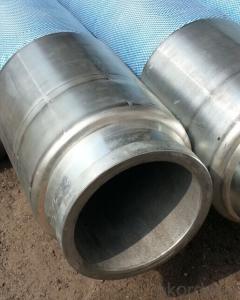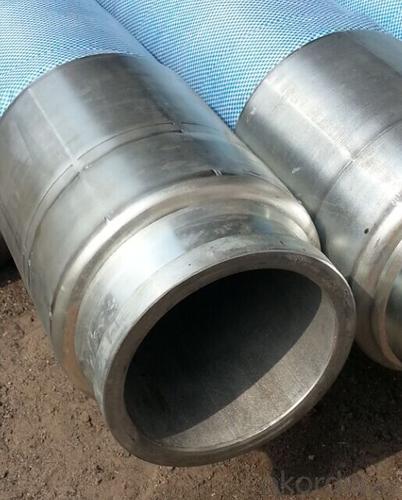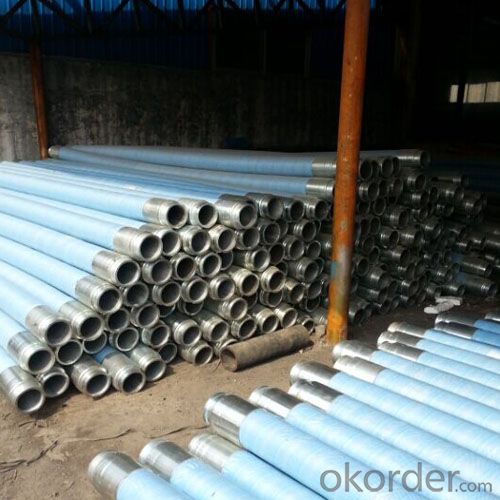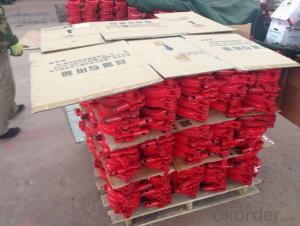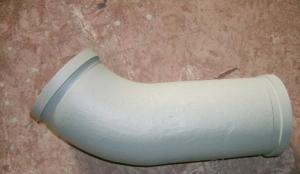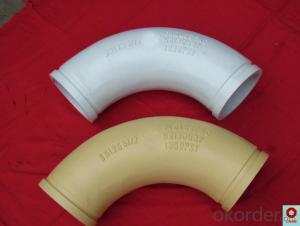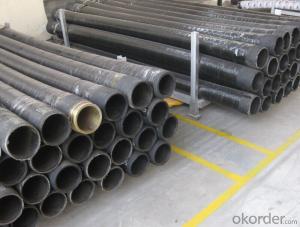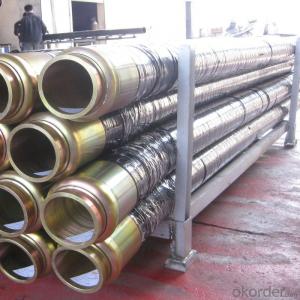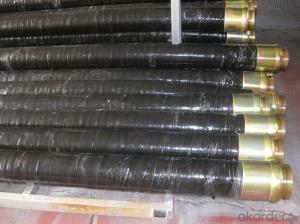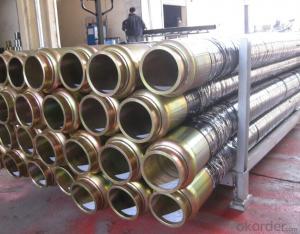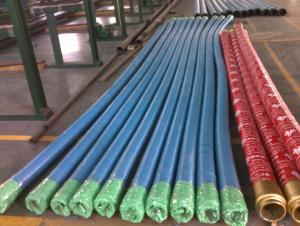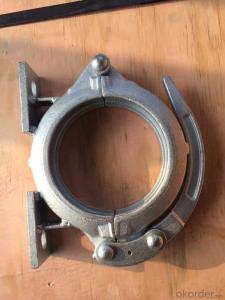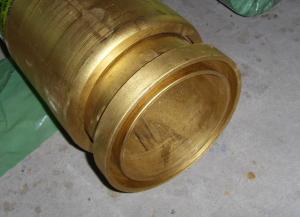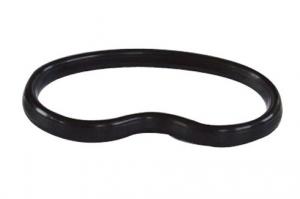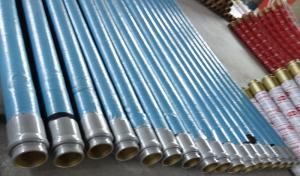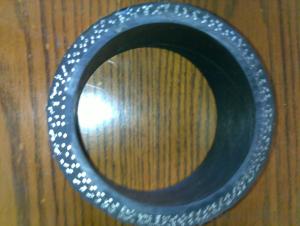Rubber End Hose With Two Side Couplings Working Pressure 85 Bar 3M*DN100
- Loading Port:
- Shanghai
- Payment Terms:
- TT OR LC
- Min Order Qty:
- 10 pc
- Supply Capability:
- 5000 pc/month
OKorder Service Pledge
OKorder Financial Service
You Might Also Like
Product Description:
The 3M*DN100 rubber end hose with two side couplings, normally the hoes is made by NR and reinforced by four layer steel wire, and the two couplings at each side are made by steel material No.ST52, 20#, 37MN5, with hot treatment according to customer’s requests, and also package in bundles or nude packing directly put into container.
Scope of Application of the hose
The 3M*DN100 rubber end hose is a concrete delivery for combined use with other concrete pipelines in concrete placement operations. It can be widely used in the construction of various types of concrete structures like industrial and civil buildings, bridges, roads, and other types of infrastructure.
Product Advantages:
OKorder's 3M*DN100 rubber end hose Channels are durable, strong, and safety. We are the biggest group in this business filed and the majority resources are under our control, which is make sure the delivery time and qualified products, meanwhile we have more than 20 overseas branches our people will go to visit customer very fast for more convenient communication.
Main Product Features:
Premium quality
· Prompt delivery & seaworthy packing (5-10 days)
Reliable performance·
Professional Service
· Competitive pricing
Measuring of wall thickness from the outside
FAQ:
Q1: How soon can we receive the product after purchase?
A1: Within three days of placing an order, we will book the vessel for goods. The specific shipping date is dependent upon international and government factors, but is typically 7 to 30 workdays.
Q2: If we can produce some pipes according to customers request?
A2: Yes, we can produce Concrete Placing Boom according to the difference country situations to make it suitable to the market and customers. We have very professional technical team to make the design.
Q3: How to make a quick resolution for after service?
A3: OKorder and our manufacture both have overseas branches all-around of world, if needed,
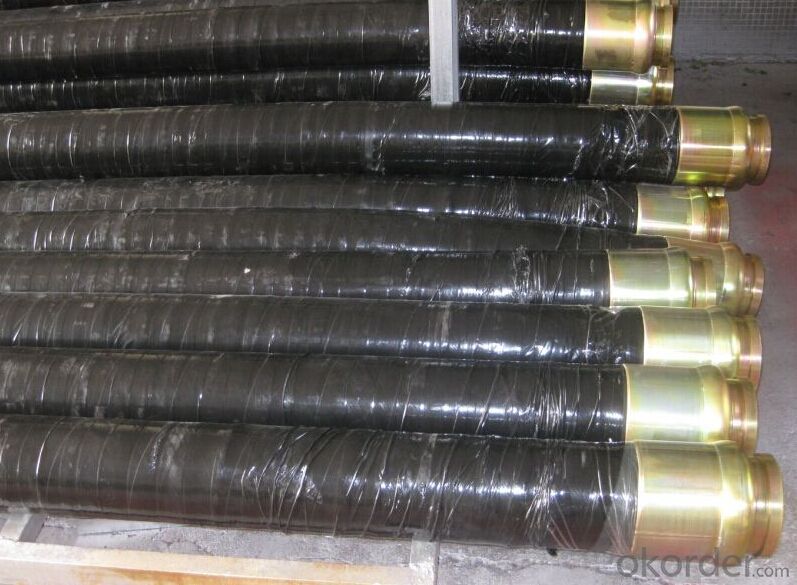
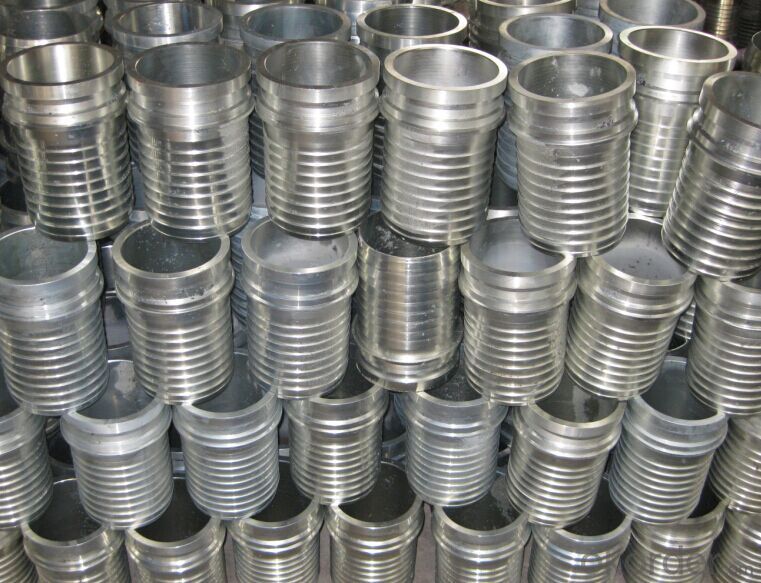
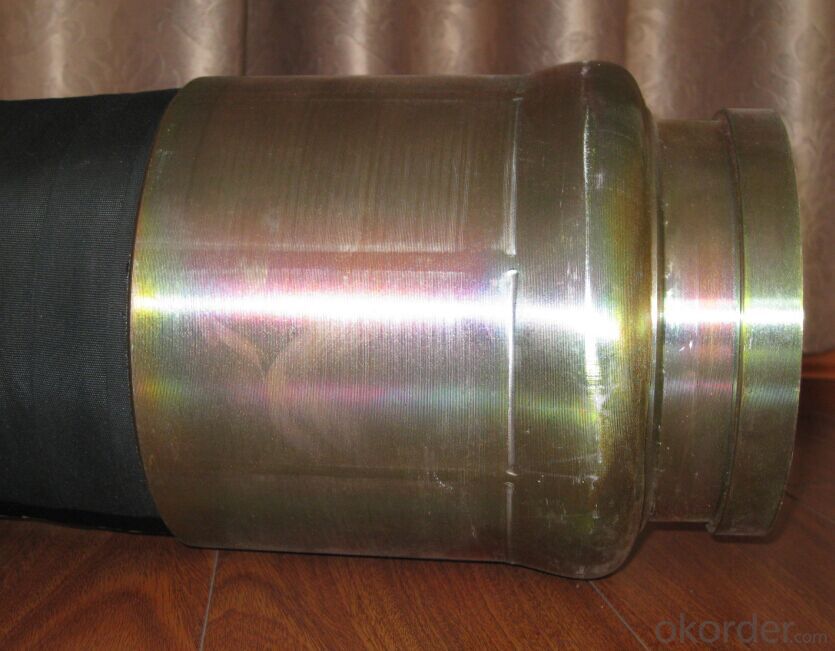
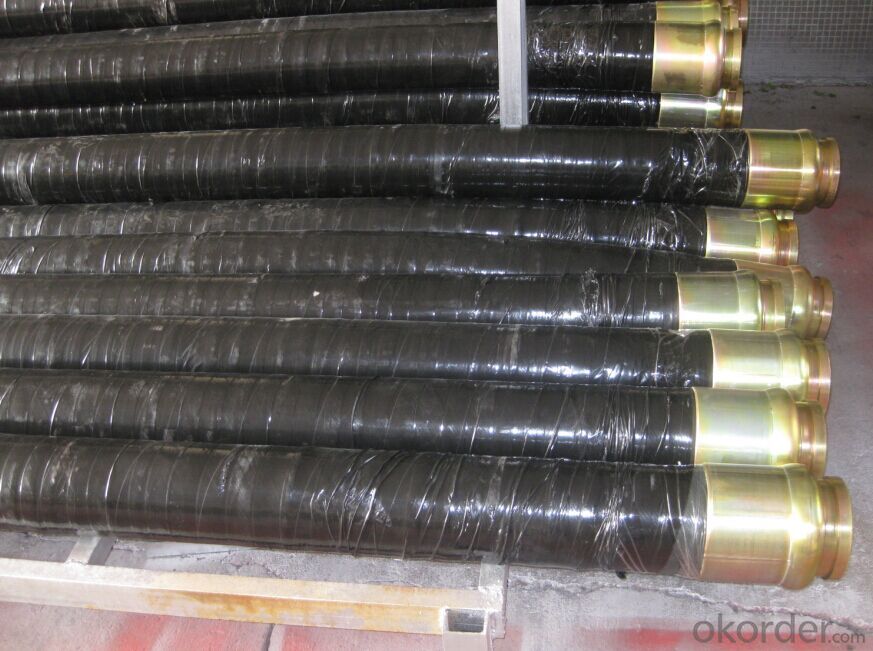
- Q: Can concrete pump spare parts be pre-assembled or pre-tested before installation?
- Concrete pump spare parts can undergo pre-assembly and pre-testing prior to installation. This allows for quality control measures to be implemented before the actual installation takes place, ensuring that any defects or issues with the parts can be identified and resolved before they are put into the concrete pump. Furthermore, pre-testing the spare parts guarantees their functionality and compatibility with the pump system, enabling any necessary adjustments or modifications to be made in advance. By engaging in these practices, the risk of complications during the installation process is reduced, resulting in a smooth and efficient operation of the pump system.
- Q: Are there any maintenance tips to extend the lifespan of concrete pump spare parts?
- Concrete pump spare parts can have their lifespan extended by implementing several maintenance tips. Cleaning the spare parts regularly to remove dirt, debris, and concrete buildup is essential. This can be achieved by using a brush, water, and mild detergent. The cleaning process helps prevent corrosion and ensures smooth operation. Proper lubrication of the moving parts is crucial to reduce friction and wear. It is important to adhere to the manufacturer's recommendations for lubrication intervals and use high-quality lubricants. The lubrication points should be inspected regularly, and any worn-out or damaged lubrication components should be replaced. Regular inspections of all spare parts are necessary to identify any signs of wear, damage, or misalignment. Any issues that are identified should be promptly repaired or replaced. Moreover, following the maintenance schedule provided by the manufacturer is essential to address any potential problems before they escalate. When the spare parts are not in use, they should be stored in a clean and dry environment to prevent rust and corrosion. Protection from extreme temperatures, moisture, and direct sunlight is also important. Additionally, the spare parts should be stored in a way that prevents any damage or deformation. Using the concrete pump in accordance with the manufacturer's guidelines is crucial. Overloading, excessive pressure, or improper operation can lead to premature wear and damage to the spare parts. Proper training should be provided to the operators to ensure they understand the correct usage techniques. Furthermore, regular maintenance of the concrete pump itself is important. This includes cleaning, lubrication, and inspections. By addressing any potential issues, the lifespan of the spare parts can be prolonged. By adhering to these maintenance tips, the need for frequent replacements of concrete pump spare parts can be reduced, resulting in long-term cost savings.
- Q: How to diagnose the blockage in the inlet of concrete pump?
- Make the pump reverse running to destroy the caking, return the concrete to the hopper, stir it again, and then pump it forward
- Q: Are there any specific warranty options available for concrete pump spare parts?
- Yes, there are specific warranty options available for concrete pump spare parts. These warranties may vary depending on the manufacturer or supplier, but they typically cover defects in materials or workmanship for a specified period of time. It is advisable to check with the manufacturer or supplier to understand the specific warranty options and terms available for concrete pump spare parts.
- Q: What are the different types of concrete pump hydraulic filters?
- Construction projects commonly utilize various types of concrete pump hydraulic filters. These filters are crucial for ensuring the hydraulic system's smooth operation and longevity. 1. Suction filters, located at the hydraulic pump's intake side, play a vital role in removing larger particles and debris from the hydraulic oil. They prevent contaminants from entering the pump and causing harm to its components. 2. Positioned on the return line, return line filters are designed to eliminate smaller particles and contaminants from the hydraulic oil before it is returned to the reservoir. By maintaining oil cleanliness, they prevent system wear and tear. 3. Pressure line filters, typically installed after the hydraulic pump on the high-pressure side, remove fine particles and contaminants from the oil. Their purpose is to guarantee the valves, cylinders, and other hydraulic components work smoothly. 4. In-tank filters are submerged in the hydraulic oil reservoir to filter the oil as it circulates through the tank. They effectively eliminate larger particles and contaminants settled at the bottom of the reservoir. 5. Magnetic filters attract and remove metallic particles, such as iron filings and metal shavings, from the hydraulic oil. They are highly effective in capturing ferrous contaminants. 6. Breather filters, installed on the breather vent of the hydraulic oil reservoir, maintain the cleanliness and integrity of the hydraulic oil by preventing dust, dirt, and moisture from entering the system. Regular inspection and replacement of these hydraulic filters are crucial for optimal performance and longevity of the concrete pump's hydraulic system. Neglecting this maintenance can lead to increased wear and tear, decreased efficiency, and potential damage to the pump and its components.
- Q: What is the function of a concrete pump control valve?
- The function of a concrete pump control valve is to regulate the flow of concrete from the pump to the desired location. It allows the operator to control the speed and direction of the concrete flow, ensuring the precise placement of the concrete. The control valve also helps in preventing any blockages or clogs in the pumping system by allowing the operator to adjust the pressure and flow rate of the concrete. Additionally, the control valve helps in maintaining the safety of the operation by providing the operator with the ability to stop or start the concrete flow as needed. Overall, the concrete pump control valve plays a crucial role in efficiently and effectively transferring concrete from the pump to the desired location.
- Q: What is the importance of a good quality concrete pump seal?
- A good quality concrete pump seal is important because it helps to prevent leakage and ensure the smooth and efficient operation of the pump. It helps to maintain the pressure and flow of the concrete, reducing the risk of blockages or malfunctions. A reliable seal also extends the lifespan of the pump by minimizing wear and tear on the internal components. Ultimately, a good quality concrete pump seal is crucial for achieving high-quality and consistent results in construction projects.
- Q: Which height of concrete pump is the most practical?
- The clay pump truck is modified on a truck chassis. It is mounted on the chassis with a power and motion device, a pump and a mixing device, a cloth arrangement, and other auxiliary devices
- Q: How often should hydraulic cylinders be inspected or replaced in a concrete pump?
- Hydraulic cylinders in a concrete pump should be inspected regularly, ideally every 500 hours of operation or at least once a year, whichever comes first. However, it is important to note that the frequency of inspections may vary depending on the specific conditions and usage of the concrete pump. During inspections, qualified technicians should thoroughly examine the hydraulic cylinders for any signs of wear, damage, or leaks. They should also check the alignment, piston rods, seals, and other components to ensure proper functioning. If any issues are found, such as excessive wear or leaks, it is recommended to replace the hydraulic cylinders promptly to prevent further damage and maintain optimal performance. Regular inspections and timely replacements of hydraulic cylinders are crucial for ensuring the safety, efficiency, and longevity of a concrete pump. Neglecting proper maintenance can lead to costly repairs, decreased productivity, and even accidents. Therefore, it is essential to follow manufacturer's guidelines and consult with professionals to determine the appropriate inspection and replacement intervals for hydraulic cylinders in a concrete pump.
- Q: How long do concrete pump spare parts typically last?
- The lifespan of concrete pump spare parts can vary depending on several factors. Generally, high-quality spare parts can last anywhere between 1,000 to 2,500 working hours. However, this estimate is influenced by factors such as the type and brand of the spare parts, the frequency of use, the quality of maintenance, and the working conditions in which the concrete pump operates. Some concrete pump spare parts may have a shorter lifespan due to the wear and tear they experience during operation. For instance, wear parts like rubber seals, pistons, and wear plates are more susceptible to damage and may need to be replaced more frequently. On the other hand, structural components like pipes, hoses, and hydraulic cylinders tend to have a longer lifespan. Proper maintenance and regular inspections play a crucial role in extending the lifespan of concrete pump spare parts. Adequate lubrication, cleaning, and timely replacement of worn-out parts can significantly enhance their durability. Additionally, the expertise and skill of the operator also influence the lifespan of the spare parts since improper use or mishandling can lead to premature failure. Overall, while the average lifespan of concrete pump spare parts can be estimated, it is important to consider the specific circumstances and conditions in which the concrete pump operates to determine their actual longevity. Regular maintenance, high-quality parts, and proper usage will ultimately contribute to maximizing the lifespan of concrete pump spare parts.
Send your message to us
Rubber End Hose With Two Side Couplings Working Pressure 85 Bar 3M*DN100
- Loading Port:
- Shanghai
- Payment Terms:
- TT OR LC
- Min Order Qty:
- 10 pc
- Supply Capability:
- 5000 pc/month
OKorder Service Pledge
OKorder Financial Service
Similar products
Hot products
Hot Searches
Related keywords


